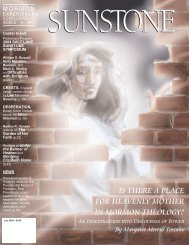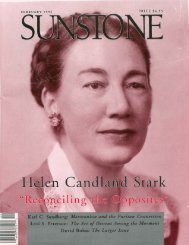Download Entire Issue PDF - Sunstone Magazine
Download Entire Issue PDF - Sunstone Magazine
Download Entire Issue PDF - Sunstone Magazine
You also want an ePaper? Increase the reach of your titles
YUMPU automatically turns print PDFs into web optimized ePapers that Google loves.
S U N S T O N E<br />
NATASHA PARKER: Pornography is becoming<br />
a regular subject in general conference<br />
addresses, and its use is currently<br />
affecting many Mormons and our culture at<br />
large. There are many who feel the Church<br />
is making pornography such a prominent<br />
topic that it is actually causing even more<br />
problems. Others express appreciation for<br />
the frank discussion and accountability<br />
that is taking place within the Church.<br />
Today we’re diverging from the usual<br />
Mormon Stories format in that I’m not interviewing<br />
a Mormon. I wanted to try to get<br />
a different perspective on the topic, so I<br />
have asked a prominent psychologist and<br />
sex therapist, Dr. Stephanie Buehler, to join<br />
us today. She is the director of the Buehler<br />
Institute, which has offices in Newport<br />
Beach and Riverside, California, and she’s<br />
the author of a recent book, Sex, Love, and<br />
Mental Illness: A Couple’s Guide to Staying<br />
Connected. Dr. Buehler treats people of all<br />
different races, cultures, and religions, and<br />
is very familiar with problematic behaviors<br />
that can be associated with pornography.<br />
Hello, Dr. Buehler!<br />
DR. STEPHANIE BUEHLER: Hello, Natasha.<br />
PARKER: Thank you so much for joining<br />
this discussion today. I have also invited<br />
John Dehlin, the founder of Mormon<br />
Stories and himself a graduate student in<br />
psychology, to join us and help me make<br />
sure we cover all the angles on this topic.<br />
So, hello, John!<br />
JOHN DEHLIN: Hello, guys! Happy to be<br />
here! Thanks for joining us, Dr. Buehler.<br />
PARKER: I thought the first place we’d start<br />
is a definition of the topic at large. As a<br />
R O U N D TA B L E<br />
PORNOGRAPHY, MASTURBATION,<br />
SEX, AND MARRIAGE IN MORMONISM<br />
with Dr. Stephanie Buehler, Natasha Helfer Parker, and John Dehlin<br />
The following is excerpted from the Mormon Stories podcast (episode 245), “Pornography,<br />
Masturbation, Sex and Marriage in Mormonism,” which was first released on 10 March<br />
2011. To hear the full discussion (about twice the length presented here), visit http://mormonstories.org/?p=1506.<br />
This excerpt is printed with the permission of all participants.<br />
therapist, one of the things I like to do<br />
when I first talk with people about pornography<br />
is to make a distinction between<br />
pornography and erotica, but I would love<br />
to get your sense of that distinction, Dr.<br />
Buehler, so that we can know what you’re<br />
talking about when you refer to pornography.<br />
BUEHLER: I think pornography is the depiction<br />
of sexual acts—whether in photos, or<br />
print, or video—designed to titillate<br />
people. Its purpose is to get people sexually<br />
aroused. Erotica does the same thing, but I<br />
think most people would think of erotica as<br />
being something that piques your interest<br />
and is maybe not so frank, so “in your<br />
face.” It is more sensual and, I think, invites<br />
the viewer to think about their own sensuality<br />
whereas pornography is really more of<br />
an exchange between exhibitionists and<br />
voyeurs—people who simply like to watch<br />
other people engage in sex acts. I think<br />
people will have different definitions of<br />
what’s erotic, and some people are going to<br />
want to stretch the boundaries a little bit,<br />
but I think if you were to look at a painting<br />
of a nude couple in an embrace, you’d call<br />
that erotic, whereas if you had movies of<br />
the same couple having sex for the sake of<br />
having sex, you might call that pornographic.<br />
PARKER: It seems to me that in the more traditional<br />
strains of Mormonism, we tend to<br />
define a lot of things as pornography that I<br />
wouldn’t necessarily define that way, so I<br />
think what you’ve shared here is an important<br />
start.<br />
DEHLIN: I’m wondering if we’re exploring<br />
this distinction because sometimes people<br />
say they need or enjoy having something to<br />
“get them going” sexually. Perhaps we’re<br />
trying to ask whether it’s okay for married<br />
couples, or for single people, or whomever,<br />
to have some light form of sexual arousal<br />
through erotica that can help them achieve<br />
whatever their sexual goals are. And if we<br />
allow for that, maybe it’s important to then<br />
have a more clearly drawn line between<br />
that and something that is socially taboo or<br />
forbidden.<br />
PARKER: Using erotica as part of your<br />
sexual repertoire is definitely an issue<br />
worth exploring. I often get someone<br />
coming in and saying things like, “I’m addicted<br />
to pornography,” or a wife who is<br />
angry that her husband is looking at<br />
pornography, but when I dig deeper the<br />
pornography they are referring to is something<br />
like looking through a Victoria’s<br />
Secret catalog or watching Dancing with the<br />
Stars or some other thing that can be erotic<br />
and sensual and maybe even inappropriate<br />
for some people but something I would<br />
never label “pornography.” So I think that’s<br />
why I want our audience to really understand<br />
what exactly it is we’re talking about.<br />
DEHLIN: I think that within the Mormon<br />
context, and probably just in most human<br />
experience, looking at pornography most<br />
often starts with somebody getting exposed<br />
to some pictures or some movies when they<br />
are in their adolescent years. In other<br />
words, their first sexual experiences are not<br />
in the context of having a partner at all, so<br />
there is probably a strong drive to engage in<br />
some type of self-stimulation. Let’s start<br />
with the adolescent experience and then<br />
move into marital relations, because many<br />
LDS leaders see this as an epidemic—that<br />
our teens are looking at porn too much and<br />
masturbating too much, and, as a result,<br />
there’s a lot of shame, a lot of charged language<br />
around this subject.<br />
BUEHLER: In the “old days,” exposure to<br />
pornography was pretty minimal. You had a<br />
“girlie” magazine, and it was probably very<br />
well worn. But these days, it’s not just<br />
looking at a couple of pictures, you’re usually<br />
on the Internet where there’s just so<br />
much material—an endless supply. And I<br />
think that part of the problem is this endless<br />
supply.<br />
In adolescence, there is a natural curiosity<br />
about the human body and about<br />
sex. From my non-Mormon perspective, a<br />
teen’s interest in sexuality is quite healthy;<br />
the desire to see the human body in all its<br />
PAGE 70 OCTOBER 2011

















